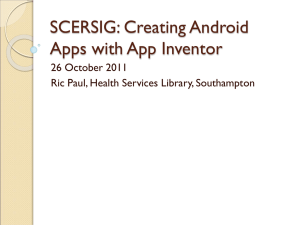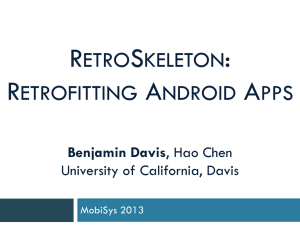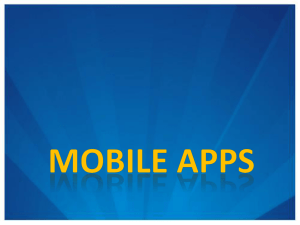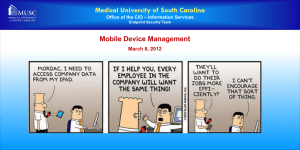web application
advertisement
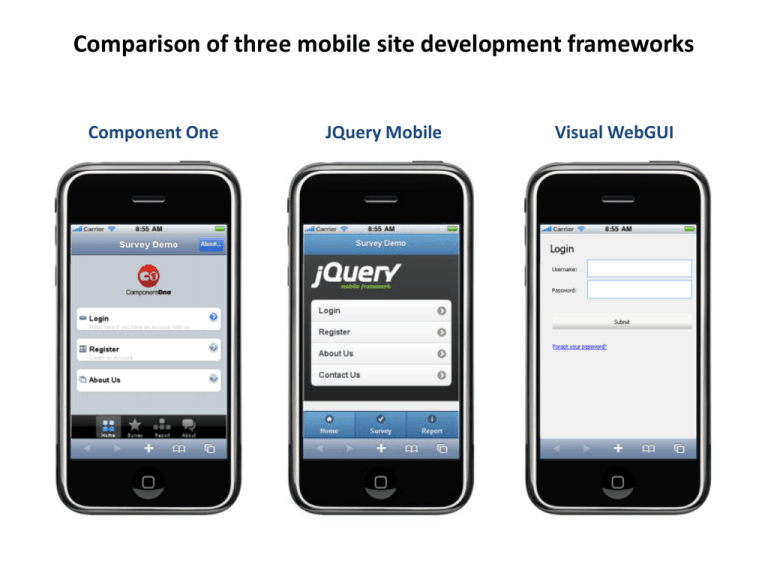
Comparison of three mobile site development frameworks Component One JQuery Mobile Visual WebGUI Comparison of three mobile site development frameworks Learning Curve Very Good Very Good Good Can use our ASP.NET skills. HTML5 syntax, based on JQuery and JQuery UI foundation Same as other .Net GUI Toolkit Efficiency of the development tools Very good Good Good Uses MS Visual Studio, with dedicated iPhone controls Online drag-and-drop UI builder included Uses MS Visual Studio, able to drag and drop GUI control to designer Developer Support Poor Poor Fair Their tech support failed to answer any of our questions during the evaluation period. Documentation Aesthetics Offer technical support package and community forum Fair Good Good Users Forums and examples Decent library of examples Have different version documentation Very Good Very Good Good ‘iPhonish’ Aspect. However customization is not easy Supports easy theming, styling with CSS or online tools ‘HTML5’ Aspect Comparison of three mobile site development frameworks Speed Fair Fair Fair Requires initial download of 61kb library. After that, execution speed is fairly smooth. Cross Platform Price Conclusion Good Very Good Bad iPhone: very good Android: good Nokia: fair Blackberry: ? 3 level “degradable” platform support: A: Full Experience B: Full Experience Minus AJAX C: Basic HTML iPhone: good Android: slider not working Nokia: fair Blackberry: ? $1100 / developer Free $749 Pro Studio with Platinum Support Open-Sourced with 1 year subscription $677 / developer $1399 Pro Studio Subscription Renewal License with 2 year subscription Good for rapid Good for building graphical Easy to learn how to development, prototyping, elements on the mobile. use. But the toolkit is still Speed and compatibility with Compatible with broad range of mobile devices that too buggy some devices may be a concern degrades with less capable browsers. Component One JQuery Mobile Main screen Visual WebGUI Component One JQuery Mobile Login screen Visual WebGUI Component One JQuery Mobile Single selection Visual WebGUI Component One JQuery Mobile Date picker Visual WebGUI Component One JQuery Mobile Slider Visual WebGUI Component One JQuery Mobile Checkbox Visual WebGUI Component One JQuery Mobile Visual WebGUI Try these examples on our dev website, at http://137.82.134.27/mobile Creating an off line Web application with HTML5 HTML is a programming language used for building and displaying web pages. Its latest edition is HTML5 which offers cool features such as: • Better aspect : native support for rounded corners, gradient colors, • Multimedia: HTML5 can render video and audio without the need of third party plugins such as Adobe Flash. • Local storage: web applications can store fair amounts of data on the user’s device. • Off line functionality: Developers can write web application that can run locally on the phone browser, without an internet connection. Websites, Web applications, Off-line Web Applications, Native Application • HTML5 offers users a better experience, beyond of the traditional websites and web applications. • To demonstrate this, we have created an off-line Web application, which we transformed later into a native application that can be downloaded on Android devices, and which uses phone’s vibration and geo-location services. • First of all, we will review the distinguish characteristics of: Websites, Web applications, Off-line Web Applications, Native Application 1. Websites: • • • • • Consist of web pages and services hosted on a remote servers Users only consume info by browsing web pages Users need internet access to those servers Everything [web pages, databases] is stored on the server Examples: Google search Figure 1: mobile website 2. Web applications: • • • • • Consist of web pages or services that allow user to accomplish some tasks Users can consume, produce or manipulate info. Users need access to Internet Everything [web pages, databases] is stored on the server Examples: reservation and/or payment systems [e.g. Amazon], calories counting application [Figure 2.b] Figure 2.a) Web application: Amazon shopping cart 2. Web applications: Figure 2.b) Web application: Kilo - a calories counting application.[1] [As seen on our development server at http://137.82.134.27/mobile] [1]: web app developed by following the examples in the book “Building iPhone Apps with HTML, CSS, and JavaScript” by J. Stark 3. Offline Web applications: • • • HTML5 apps can run offline on devices that support this feature. Offline web apps can use data stored on device into a local database. To make a web application run locally on iPod, for instance, tap on the “+” sign at the bottom of the screen, and then select “Add to Home Screen” as seen in Figure_3. After that, the app can be launched from icon on the iPod’s home screen, even without internet connection! Launch App Figure 3: How to store a web application into an iPod touch 3. Off line Web applications [continued]: • A well written web app can look and behave like a native one, as seen in Figure 4: Figure 4: Side-by-side look at Facebook’s native app and mobile web app: [source: http://sixrevisions.com/mobile/native-app-vs-mobile-web-app-comparison/] 4. Native and Hybrid applications: • While off line Web Application can run …well, off line, and look and behave like native apps, they can access only a limited set of the features on the mobile phones, as seen in Table 1 4. Native and Hybrid applications [continued]: To overcome these limitations, there are two possibilities: 1. Write a pure native app, which may not practical when targeting more than two types of devices, since, for instance, the same app developed for Android will not run on iPhone. 2. Create a hybrid app, which is a Native App with a Web App Inside. With a hybrid app, the entire user interface appears in a browser window, with a native app wrapped around it to provide access to device functionality not available via the browser [1]. By using a specialized tool, PhoneGap, we were able to transform our WebApp into an Android hybrid app that can be downloaded from our development website. In this new incarnation, our app is now able to access the vibration and geo-location features of the cell phones. PhoneGap offers a cloud based service that can transform a HTML5 web applications into hybrid for a large number of devices: iPhone/iPad/iPod, Android, Symbian [Nokia], BlackBerry, Samsung Bada, WebOS, Windows Phone [1] Source: Lionbridge: Mobile Web Apps vs. Mobile Native Apps: How to Make the Right Choice Try these examples on our dev website, at http://137.82.134.27/mobile QUESTIONS?



